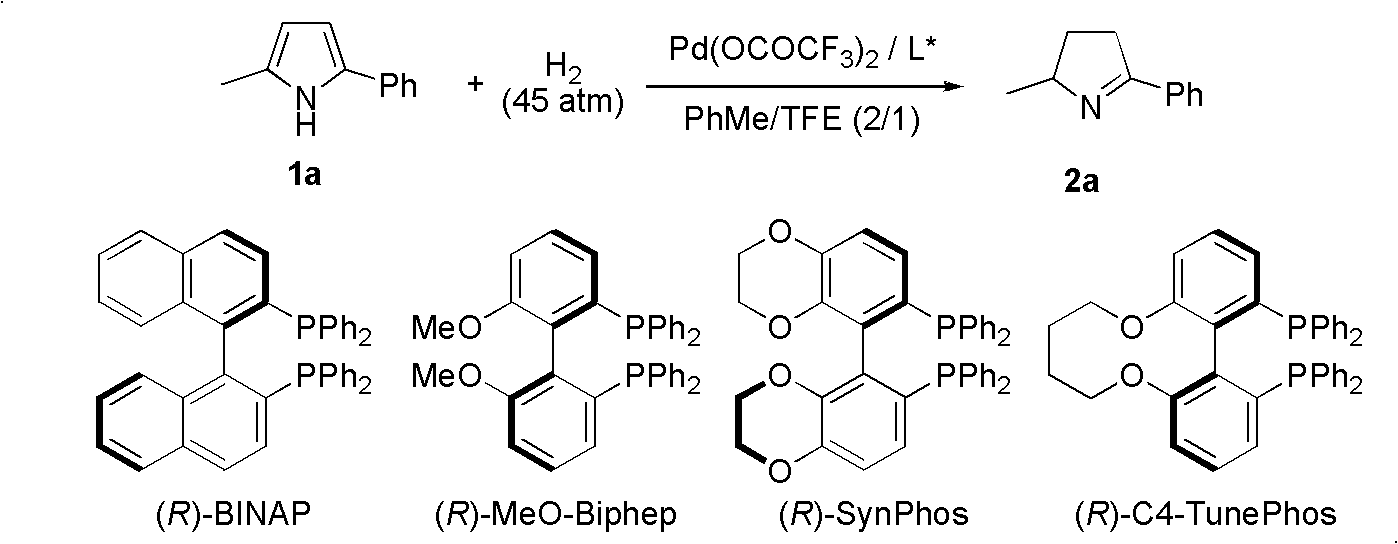Chiral pyrroline synthetic method by palladium-catalyzed asymmetric hydrogenation
A dihydropyrrole, asymmetric technology, applied in the direction of organic chemistry, can solve the problems of no literature reports, etc., and achieve the effect of convenient separation, good reactivity and chemical selectivity, and high enantioselectivity
- Summary
- Abstract
- Description
- Claims
- Application Information
AI Technical Summary
Problems solved by technology
Method used
Image
Examples
Embodiment 1
[0027] Embodiment 1: optimization of conditions
[0028] Put palladium precursor: palladium trifluoroacetate (0.005 mmol) and chiral ligand: bisphosphine ligand (0.006 mmol) in the reaction flask, add 1 ml of acetone after nitrogen replacement, stir at room temperature for 1 hour and then concentrate in vacuo to remove Acetone gets the catalyst. Add 1 ml of solvent (toluene and trifluoroethanol (2 / 1) ), stirred for 5 minutes, then dissolved and transferred the previously prepared catalyst into a reaction flask with 2 milliliters of solvent, then put it into a high-pressure reactor, fed hydrogen (45 atmospheric pressure), and reacted at 60° C. for 24 hours. Slowly release the hydrogen gas, stir with 5 ml of saturated sodium bicarbonate at room temperature for 10 minutes to make it alkaline, remove the activator acid, extract with dichloromethane (3×5 ml), combine the organic phases, dry over anhydrous sodium sulfate, filter and spin The solvent is removed by evaporation, and ...
Embodiment 2
[0034] Example 2: Synthesis of various chiral dihydropyrroles by palladium-catalyzed asymmetric hydrogenation 2
[0035]Put palladium trifluoroacetate (0.005 mmol) and (R)-C4-TunePhos (0.006 mmol) into the reaction flask, add 1 ml of acetone after nitrogen replacement, stir at room temperature for 1 hour and then concentrate in vacuo to remove acetone to obtain a catalyst. In the glove box, add 1 ml of solvent (toluene and trifluoroethanol (2 / 1)) to the reaction flask with substrate (0.25 mmol) and ethanesulfonic acid (0.375 mmol) in advance, stir for 5 minutes, and then The previously prepared catalyst was dissolved with 2 ml of solvent and transferred to a reaction bottle, then put into a high-pressure reactor, and hydrogen gas (45 atmospheres) was introduced, and the reaction was carried out at 60° C. for 24 hours. Slowly release the hydrogen gas, stir with 5 ml of saturated sodium bicarbonate at room temperature for 10 minutes to make it alkaline, remove the activator acid...
Embodiment 3
[0048] The difference from Example 2 is that the raw material used is 2,5-dibenzylpyrrole (pyrrole substrate with both 2,5-positions being alkyl).
[0049] The invention has simple and practical operation, easy to obtain raw materials, good enantioselectivity and high yield, and the subsequent conversion of reaction products can be conveniently carried out.
PUM
 Login to View More
Login to View More Abstract
Description
Claims
Application Information
 Login to View More
Login to View More - R&D
- Intellectual Property
- Life Sciences
- Materials
- Tech Scout
- Unparalleled Data Quality
- Higher Quality Content
- 60% Fewer Hallucinations
Browse by: Latest US Patents, China's latest patents, Technical Efficacy Thesaurus, Application Domain, Technology Topic, Popular Technical Reports.
© 2025 PatSnap. All rights reserved.Legal|Privacy policy|Modern Slavery Act Transparency Statement|Sitemap|About US| Contact US: help@patsnap.com



